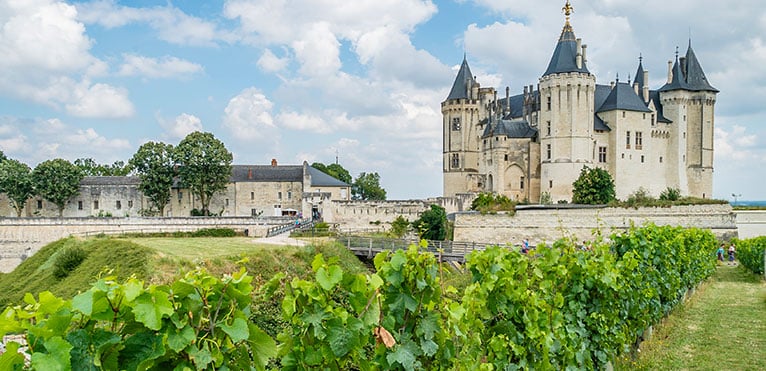
Contents
The Montlouis-sur-Loire vineyard, located between Amboise and Tours, benefits from the presence of the Loire and Cher rivers on either side of its territory. The appellation’s wines, made from Chenin alone, are highly diversified: still wines from dry to sweet, and sparkling and semi-sparkling wines. Montlouis-sur-Loire wines were historically sold under the Vouvray appellation, but have been recognized as such by an AOP (at European level) and an AOC (at French level) since December 6, 1938.
Montlouis-sur-Loire viticulture has developed thanks to the presence of the Loire River.
The history of Montlouis-sur-Loire’s vineyards dates back to the 5th century, when the ancient village of Mons Laudium began cultivating vines. The presence of the Loire River, on which it was still possible to sail at the time, and the town’s harbor enabled the development of this vineyard. Although the Loire is no longer navigable, winegrowing has remained deeply rooted in the region’s culture.
The vineyards of Montlouis-sur-Loire lie at the confluence of the Loire and Cher rivers.
This 430-hectare vineyard faces the Vouvray appellation, to which it originally belonged. Where two valleys meet, the Montlouis-sur-Loire appellation lies upstream from Tours, bordered on both sides by the Loire and Cher rivers. The relief of this area is marked by its particular position between two rivers, allowing vines to be planted at quite different altitudes (between 50 and 100 meters). At the top of the vineyard, clay soils rich in flint and chalk are covered with sands from the Loire and Cher rivers. On either side of the vineyard, the slopes that meet the rivers give the roots more direct access to deeper soils such as the tuffeau, for which Touraine wines are renowned.
The proximity of the two rivers, which allows the oceanic climate to enter the two valleys, and the presence of the Amboise forest massif to the east of the vineyard give it a particularly mild climate, allowing the grapes to be over-ripened. The region’s hot summers always exceed 33°C. Winters are not very cold, with temperatures rarely dipping below -10°C. However, this climate is not constant, and so, depending on the vintage, we obtain semi-dry to sweet wines.
Chenin Blanc, Montlouis-sur-Loire’s flagship grape variety
Montlouis-sur-Loire wines are all made from a single grape variety: Chenin Blanc, also known as Pineau de la Loire. Although all the appellation’s production is white, there is a wide variety of wines, from still dry, semi-dry and sweet white wines to sparkling and sparkling.
The color of Montlouis-sur-Loire wines is deep and luminous, straw-yellow for sparkling wines. Sweet wines have a golden color that takes on amber hues as they age. All the appellation’s young wines have a floral, fruity nose, expressing notes of white flowers, verbena, citrus fruits such as bergamot and bitter almond. While sparkling wines are best drunk young, the evolution of these wines over time can be observed in the still sweet wines, whose sugar content gives them a great aptitude for ageing, with a slow, delicate evolution. In the early years, fruity notes evolve towards exotic fruit, such as mango or lychee, and between 5 and 10 years of age, Montlouis-sur-Loire wines develop sweet aromas of honey, quince and candied fruit. However, the sweetness of these mellow wines is counterbalanced by a beautiful minerality that allows us to appreciate their full range of aromas. On the palate, these wines are soft, full-bodied and opulent, depending on their age, but they always retain the freshness typical of the region’s “taffeta wines”. It is this freshness that makes the quality of dry and sparkling white wines.
Pair Montlouis-sur-Loire with round, tasty dishes
Sparkling and sparkling wines, considered festive, can easily be served as aperitifs. However, served at the table, they can be a sensation, replacing a dry white wine to accompany warm oysters or poultry dishes.
Dry white Montlouis-sur-Loire wines are the perfect accompaniment to fish and shellfish dishes, which sublimate their freshness and minerality. For example, a fillet of pike-perch or scallops in cream sauce. Sea bream cooked in white wine is a perfect match for these wines.
Finally, the appellation’s mellow wines are a classic aperitif or accompaniment to foie gras, but they also go wonderfully well with gourmet, fruity desserts such as poached white peaches, which can be cooked in a Montlouis-sur-Loire wine, or rhubarb tart. When the wine is older, a nougat glacé brings out the honey notes while adding freshness on the palate.
Vintages have a strong influence on Montlouis-sur-Loire wines
The years 1959 and 1989 are considered to be the best in the Montlouis-sur-Loire vineyard, and have been consecrated as crus du millénaire. The year 1945 is also considered exceptional and recognized as the vintage of the century. Other outstanding vintages include 1971, 1976, 1985, 1990 and 2002.
Relatively new, highly promising estates in Montlouis-sur-Loire
Domaine La Croix Mélier
Established for five generations, Domaine La Croix Mélier was historically organized around mixed farming, a very common practice at the time, but since the 1980s it has devoted itself to viticulture. This choice led to tremendous growth in the domain in the years that followed. Today, the winegrowers are embarking on a new stage in the history of this Montlouis sur Loire estate, returning to an older family tradition that is closer to the land and nature.
Domaine Jousset
Created by Lise and Bertrand Jousset in 2003, this young estate produces wines made to be drunk and shared. This is the vocation of this couple, who intend to produce wines for every occasion. Since their first vintage, they have been producing organic wines, and pay particular attention to their vines in a sustainable approach.